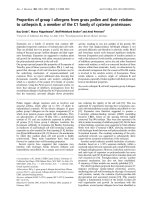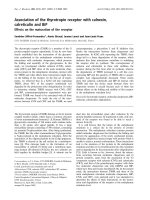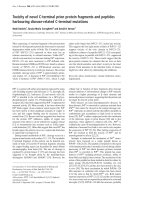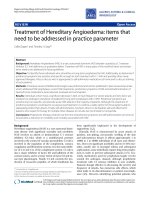Báo cáo y học: " Preparation of RGD-modified Long Circulating Liposome Loading Matrine, and its in vitro Anti-cancer Effects"
Bạn đang xem bản rút gọn của tài liệu. Xem và tải ngay bản đầy đủ của tài liệu tại đây (1.18 MB, 12 trang )
Int. J. Med. Sci. 2010, 7
197
I
I
n
n
t
t
e
e
r
r
n
n
a
a
t
t
i
i
o
o
n
n
a
a
l
l
J
J
o
o
u
u
r
r
n
n
a
a
l
l
o
o
f
f
M
M
e
e
d
d
i
i
c
c
a
a
l
l
S
S
c
c
i
i
e
e
n
n
c
c
e
e
s
s
2010; 7(4):197-208
© Ivyspring International Publisher. All rights reserved
Research Paper
Preparation of RGD-modified Long Circulating Liposome Loading Matrine,
and its in vitro Anti-cancer Effects
Xiao-yan Liu
1
, Li-ming Ruan
1
, Wei-wei Mao
2
, Jin-Qiang Wang
2
, You-qing Shen
2
, Mei-hua Sui
2
1. The First Affiliated Hospital, College of Medicine, Zhejiang University, Hangzhou, Zhejiang 310003, China
2. Department of Chemical and Biological Engineering, Zhejiang University, Hangzhou, Zhejiang 310027, China
Corresponding author: Li-ming Ruan, The First Affiliated Hospital, College of Medicine, Zhejiang University, #79
Qingchun Road, Hangzhou, Zhejiang 310003, China. Tel: +8613957121201; Email: Mei-hua Sui, Depart-
ment of Chemical and Biological Engineering, Zhejiang University, Hangzhou, Zhejiang 310027, China. Tel: +8615888847026;
email:
Received: 2010.05.13; Accepted: 2010.06.09; Published: 2010.06.14
Abstract
Aim: To prepare RGD-modified long circulating liposome (LCL) loading matrine
(RGD-M-LCL) to improve the tumor-targeting and efficacy of matrine. Methods: LCL which
was prepared with HSPC, cholesterol, DSPE-PEG2000 and DSPE-PEG-MAL was modified
with an RGD motif confirmed by high performance liquid chromatography (HPLC). The
encapsulation efficiency of RGD-M-LCL was also detected by HPLC. MTT assay was used to
examine the effects of RGD-M-LCL on the proliferation of Bcap-37, HT-29 and A375 cells.
The percentage of apoptotic cells and morphological changes in Bcap-37 cells treated with
RGD-M-LCL were detected by Annexin-V-FITC/PI affinity assay and observed under light
microscope, respectively. Results: Spherical or oval single-chamber particles of uniform sizes
with little agglutination or adhesion were observed under transmission electronic micro-
scope. The RGD motif was successfully coupled to the DSPE-PEG-MAL on liposomes, as
confirmed by HPLC. An encapsulation efficiency of 83.13% was obtained when the drug-lipid
molar ratio was 0.1, and the encapsulation efficiency was negatively related to the drug-lipid
ratio in the range of 0.1~0.4, and to the duration of storage. We found that, compared with
free matrine, RGD-M-LCL had much stronger in vitro activity, leading to anti-proliferative and
pro-apoptotic effects against cancer cells (P<0.01). Conclusion: RGD-M-LCL, a novel deli-
very system for anti-cancer drugs, was successfully prepared, and we demonstrated that the
use of this material could augment the effects of matrine on cancer cells in vitro.
Key words: Matrine, Liposomes, Cyclic arginine- glycine-aspartic acid, Drug delivery systems.
Introduction
Matrine, the major active component of the tra-
ditional Chinese medicine Sophora flavescens, has been
used to treat jaundice, reduce liver enzyme activity,
and prevent hepatic fibrosis (1,2). In recent years,
studies have indicated that matrine also inhibits tu-
mor cell proliferation (3), and induces cellular diffe-
rentiation (4) and apoptosis (5). Our previous study
showed that matrine could inhibit proliferation and
induce apoptosis in human malignant melanoma
A375 cells in a dose-dependent manner. Furthermore,
it effectively suppressed their adhesion and inva-
siveness in vitro (6). However, like most low molecu-
lar weight drugs, matrine is able to freely traverse in
and out of blood vessels to distribute to non-tumor
tissues, resulting in accumulation in the liver, spleen
or kidneys, diminishing its effects on cancer cells. In
addition, consistent with the results of other research
groups, our previous study also showed that matrine
Int. J. Med. Sci. 2010, 7
198
had fewer side-effects and broader indications com-
pared with conventional anti-cancer drugs. However,
its anti-tumor activity was moderate, and its half
maximal inhibitory concentration (IC50) was about
2.01mM (6).
In order to improve the tumor-specificity and
efficacy of anti-tumor drugs, liposomes have been
used extensively as delivery systems in both
pre-clinical and clinical applications. Liposomes allow
for enhanced drug delivery into tumors, and improve
the accumulation of drugs in tumors via the enhanced
permeability and retention (EPR) mechanism (7).
However, the use of conventional vesicles cannot
fully overcome their binding with serum components
and uptake by mononuclear phagocyte system (MPS).
To overcome such problems, long circulating lipo-
somes, modified with a hydrophilic or a glycolipid
such as poly (ethylene glycol) (PEG) or
monosialogan-
glioside
(GM1), have been developed in the past sev-
eral years.
The presence of PEG on the surface of the
liposomal carrier has been
shown to extend
blood-circulation time while reducing
MPS
uptake
(
8
)
.
Furthermore, several novel types of liposomes, such
as ligand- or antibody-mediated liposomes (9,10),
have been developed to further enhance their tu-
mor-specificity and therapeutic efficacy. The use of
these specific “vector” molecules showing affinity
toward certain receptors or antigens highly expressed
on the surface of the target tumor cells enhances their
uptake and activity. Among the most commonly tar-
geted are the integrin receptors, including α
5
ß
1
, α
γ
ß
3
or α
4
ß
1
,
which are highly expressed on breast, colon
and rectal cancer, and melanoma cells (11-13). There-
fore, the arginine-glycine-aspartic acid (RGD) peptide,
which is a ligand of several integrin receptors, has
been used to modify oncolytic viral vectors, delivery
vehicles, and the resulting molecules have been used
as probes and radiotracers for tumor imaging (14-18).
However, linear RGD-peptides are susceptible to
chemical degradation, so the peptides were cyclized
to confer rigidity and increase stability (19).
In this study, we prepared liposomes loaded
with matrine using hydrogenated soybean phospha-
tidylcholine (HSPC), cholesterol, 1,2- distea-
royl-sn-glycero-3-phosphoethanolamine
-N-[PEG(2000)] (DSPE-PEG2000) and malei-
mide-[poly (ethylene glycol)]-1,2-dioleoyl-sn
-glycero-3-phosphoethanolamine (DSPE-PEG-MAL),
and modified them with RGD. The novel therapeutic
approach was then evaluated by in vitro testing in
human cancer cell lines. We observed that
RGD-M-LCL had increased anti-proliferative activity
and increased the induction of apoptosis in cancer
cells compared to free matrine, supporting the further
development of this novel delivery system for cancer
therapy.
Materials and Methods
Preparation of RGD-modified long circulating
liposome (LCL) loading matrine (RGD-M-LCL)
Lipids composed of HSPC (Lipoid, Germany),
cholesterol (Lipoid, Germany), DSPE-mPEG2000
(Avanti, USA) and DSPE-PEG-MAL (Avanti, USA) in
a molar ratio of 2:1:0.1:0.01, were dissolved in chloro-
form:methanol (9:1 vol/ vol) in a round-bottom flask.
The solvent was evaporated to form a lipid film under
reduced pressure and constant rotation (Rotovapor
R-200, Buchi, Switzerland) at 40°C. The lipid film was
hydrated with 300mmol/L citric acid (pH 4.0) at 62°C
for 1 h, and in a magnetic stirrer for another 1 h, fol-
lowed by ultrasonication in an ice bath for 15 min.
Then the sample of LCL was delivered to the Zhejiang
California International NanoSystems Institute, and
was processed by a m
icrofluidizer (Microfluidics
,
USA). After microf
luidizing
, the LCL suspension was
stored at 4°C until use.
The Cyclic-RGD peptide (Arg-Gly-Asp-
D-Phe-Cys, purity assayed by HPLC to be >98%) was
synthesized by the Chinese Peptide Company
(Hangzhou, China) and dissolved in 50 mM HEPES
buffer (pH 6.5) at 1mg/mL, then the peptide was
reacted with the LCL suspension with maleimide
functional groups in a molar ratio of 1:10
(RGD:maleimide) at room temperature overnight to
prepare RGD-LCL. In this step, the sulfhydryl (-SH)
group of cystine in the Cyclic-RGD couples to the
maleimide groups at the distal end of
DSPE-PEG-MAL on the liposomes (Figure 1) (20).
Then, referring to the pH-gradient method (21), ma-
trine (purity determined to be >99% by HPLC, Nanj-
ing Tcm Institute Of Chinese Materia Medica, China)
was added to the RGD-LCL in a drug-lipid ratio of
0.1, 0.2 or 0.4, respectively, and mixed with NaH
2
PO4
(pH 7.0) to obtain a desired pH gradient (inside pH
4.0, outside pH7.0). Subsequently, the mixture was
incubated under argon at 60°C for 30 min, and then
the generation of RGD-modified long circulating li-
posome loading matrine (RGD-M-LCL) was com-
plete. Some RGD-M-LCL in a drug-lipid ratio of 0.1
was stored at 4°C to determine its stability, particle
size and the efficiency of drug-loading.
Int. J. Med. Sci. 2010, 7
199
Figure 1. Schematic representation of the coupling reaction between the maleimide group on the distal end of the PEG
chain on the LCL and the -SH group in the cyclic RGD peptide (19).
HPLC analysis of the coupling of RGD to LCL
Free Cyclo-RGD (250μg/mL or 15μg/mL) and
conjunctive RGD-LCL equivalent to 15μg/mL RGD
were analyzed by HPLC to ascertain the status of
RGD. A Hypersil-BDS-C18-column (4.0 × 250 mm,
Thermo, USA) was used with a mobile phase con-
sisting of 0.05% trifluoroacetic acid in water (eluant A)
and 0.05% trifluoroacetic acid in acetonitrile (eluant
B). The eluant gradient was set from 10% to 60% B in
50 min, and subsequently back to 10% B over 5 min
(19). The detection wavelength was 214nm, the flow
rate was 1mL/min, and the injection volume was
20μL.
Lyophilization of RGD-M-LCL and measurement
of its particle size
RGD-M-LCL was freeze-dried by a cryoprotec-
tant of sugar in a sugar-lipid quality ratio of 2.0 (22),
then was redissolved with DMEM. The size of the
liposomes was measured before and after
freeze-drying by a Zetasizer Nano (Malvern, United
Kingdom). In addition, the samples were delivered to
the Electronic Microscope Centre of Huajiachi Cam-
pus, Zhejiang University. Subsequently, liposomes
were dyed with 3% phosphotungstic acid for negative
staining, and then deposited to a copper screen for
observation under transmission electronic microscope
(Tecnai-co, Philip, the Netherlands) to evaluate their
shape.
Encapsulation efficiency and loading-drug stabil-
ity of the RGD-M-LCL.
Matrine solutions at different concentrations
(1.95 μg/mL, 3.91 μg/mL, 7.81 μg/mL, 15.63 μg/mL,
31.25 μg/mL, 62.5 μg/mL, 125 μg/mL and 250
μg/mL) were prepared. A Hypersil-BDS-C18-column
was used with a mobile phase consisting of acetoni-
trile-alcohol-0.2% triethylamine (8:2:90, pH adjusted
to 3.0 with phosphoric acid), the detection wavelength
was 210nm, the flow rate was 1mL/min and the in-
jection volume was 20μL. The unloaded matrine from
different RGD-M-LCL samples obtained immediately
after encapsulation, one or two weeks after encapsu-
lation, or following re-dissolution after freeze-drying,
was separated by mini-gel columns of Sephadex-G50
prepared in advance. In brief, incubation mixtures of
200μL containing unloaded matrine and RGD-M-LCL
were added onto mini-gel columns. Then particles of
RGD-M-LCL were collected by centrifugation at
2000rpm/min for 3min, while the free matrine was
still isolated in the columns because of their differ-
ences in the sizes of the molecules. The amount of
matrine collected from the RGD-M-LCL samples was
determined by HPLC assay under the same condi-
tions. At the same time, total matrine present in each
group before separation was also measured by HPLC.
The encapsulation efficiency was calculated as Effi-
ciency = Matrine separated from liposomes (encap-
sulated)/matrine in unseparated liposomes (total)
×100%.
Cell culture
The A375 melanoma cell line was purchased
from the Shanghai Institute of Cell Biology, Chinese
Academy of Sciences (Shanghai, China). The breast
cancer Bcap-37 and colon cancer HT-29 cell lines were
maintained in our lab. A375 cells and Bcap-37 cells
were grown in RPMI1640 medium (GIBCO, USA)
containing 10% heat-inactivated fetal bovine serum
(Nuoding, China), and the HT-29 cells were grown in
DMEM medium (GIBCO, USA) also containing 10%
heat-inactivated fetal bovine serum. All of the cells
were incubated at 37°C in a humidified atmosphere
Int. J. Med. Sci. 2010, 7
200
with 50 mL/L CO
2
. RGD-M-LCL and RGD-LCL were
re-dissolved with DMEM or RPMI1640 after
freeze-drying.
Effects of RGD-M-LCL on cell viability using
MTT) assay
Briefly, cells (5×10
3
per well) were seeded in
96-well plates (Corning, USA). After subculturing
them for 24 h, the cells were treated with matrine of
different concentrations (0.0625 mg/mL, 0.125
mg/mL, 0.25 mg/mL, 0.5 mg/mL) or RGD-M-LCL
with matrine of equivalent concentrations. The con-
trol group consisted of cells in culture medium only.
Experiments were carried out in triplicate. In order to
observe the toxicity of RGD-LCL without matrine on
cells, Bcap-37 cells were also treated with RGD-LCL of
different concentrations (0.3125 mg/mL, 0.625
mg/mL, 1.25 mg/mL, and 2.5 mg/mL), and
RGD-M-LCL of different concentrations equivalent to
these RGD-LCL concentrations. After exposure for
48h, 100 μL of MTT (1 mg/mL) (Sigma-Aldrich, USA)
was added to each well and the plates were incubated
for an additional 4 h at 37°C. The MTT solution was
removed by aspiration, and 150 μL of dimethylsul-
foxide (DMSO) (Sigma-Aldrich) was added to each
well. Finally, the absorbance of each well was meas-
ured at 570 nm. All MTT assays were repeated two
times. The relative growth rate was calculated as A570
(test)/A570 (control). We assumed that the average
A570 values of the control group were equal to 1, and
then generated a histogram of cellular viability ac-
cording to the relative growth rate following the dif-
ferent treatments.
Morphological observation
Bcap-37 cells were seeded in 96-well plates for 24
h before treatments as follows: matrine at 0.03215
mg/mL or 0.0625 mg/mL, RGD-LCL at 0.625 mg/mL
or 1.25 mg/mL, or RGD-M-LCL equivalent to the
same concentrations of matrine and RGD-LCL. After
being exposed to the different treatments for 48h, the
Bcap-37 cells were observed under inverted light mi-
croscope (Olympus, Tokyo, Japan).
Effect of RGD-M-LCL on cellular apoptosis
The Annexin-V–fluorescein isothiocya-
nate/propidium iodide (Annexin-V-FITC/PI) double
staining assay was used to detect cellular apoptosis.
Bcap-37 cells were equally distributed into culture
flasks, and treated with either culture medium only,
matrine at 0.03215 mg/mL, RGD-LCL at 0.625
mg/mL, or RGD-M-LCL equivalent to these concen-
trations of matrine and RGD-LCL. After 24 h of
treatment, the cells were collected, washed with cold
phosphate-buffered saline (PBS), and resuspended at
2 × 10
6
cells /mL in Annexin-V binding buffer. The
supernatant (100 μL/tube) was incubated with 5 μL of
Annexin-V-FITC (Invitrogen, USA) and 5 μL of PI
(Invitrogen, USA) for 15 min at room temperature in
dark. Binding buffer (400 μL) was then added to each
tube, followed by cytometric analysis (Coulter-XL,
USA) within 1 h of staining. All experiments were
repeated three times.
Statistical analysis
The SAS statistical software was used for statis-
tical analyses. The results are expressed as the means
± standard deviations, and samples were subjected to
multiple analysis of variance. The Dunnett-t test was
performed to compare the mean between each test
group and control group, and the SNK-q test was
performed to compare the means between either two
test groups. P < 0.05 was considered to be statistically
significant.
Results
The RGD motif was successfully coupled to
DSPE-PEG-MAL on liposomes
HPLC analysis showed that free RGD at con-
centrations of 250 μg/mL or 15 μg/mL eluted with a
retention time of ~20 minutes, and the peak area was
dose-dependent. However, when RGD was conju-
gated to liposomes at the same concentration (15
μg/mL) following the coupling step, there was no
significant peak for the free RGD around 20 minutes
(Figure 2), indicating successful coupling of the RGD
to the surface of the liposomes.
Assay of particle sizes and morphological ob-
servation of RGD-M-LCL
The average size of liposomes processed by the
microfluidizer was 97.59±1.93nm, with the liposomes
appearing as a light milky-white and translucent
suspension. Liposomes were found to be spherical or
oval single-chamber particles of uniform sizes with
little agglutination or adhesion under transmission
electronic microscope. They showed little change in
appearance or size when stored for one week, two
weeks or four weeks at 4°C. However, the average
size of liposomes re-dissolved after freeze-drying in-
creased to 295.77±5.52nm, and presented as larger
particles with some
agglutination under
transmis-
sion electronic microscope (Figure 3-4, Table 1)
.
Int. J. Med. Sci. 2010, 7
201
Figure 2. HPLC confirmation of RGD coupling to the liposomes. (A) Free RGD at 250 μg/mL eluted with a re-
tention time of ~20 minutes; (B) Free RGD at 15 μg/mL also eluted with a retention time of ~20 minutes, and the peak areas
of the peaks in A and B demonstrate dose-dependence; (C) The liposome sample modified with the same concentration of
15 μg/mL RGD following the coupling step showed no significant peak for the free RGD around 20 minutes.









